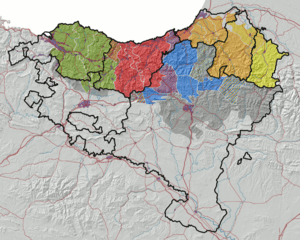Biscayan dialect
| Biscayan | |
|---|---|
| Bizkaiera | |
| Native to | Spain |
| Region | Biscay, into Álava and Gipuzkoa |
Native speakers | (no estimate available) |
|
Basque
| |
| Dialects |
Alavese (extinct)
|
| Language codes | |
| ISO 639-3 | – |
| Glottolog |
bisc1236 (Biscayan)[1]aval1237 (Alavan)[2] |
|
Biscayan | |
Biscayan, sometimes Bizkaian (Basque: Bizkaiera), is a dialect of the Basque language spoken mainly in Biscay, one of the provinces of the Basque Country of Spain.
It is the only member of the western branch of the Basque language, with the dialect being named as Western in the classification drawn up by linguist Koldo Zuazo, since it extends slightly into the fringes of Alava and deeper in the west region of Gipuzkoa. The dialect's territory bears great similarity to that of the Caristii tribe, as described by Roman authors.
While it is treated as stylish to write in Biscayan, and it is still spoken generally in about half of Bizkaia and some other municipalities, the dialect suffers from the double pressure of Unified Basque and Spanish.
Biscayan was used by Sabino Arana and its early Basque nationalist followers as one of the signs of Basqueness.
Comparative traits
Some features of Biscayan as perceived by other dialect speakers may be summed up as follows:
- The verb root "eutsi" used for the dative auxiliary verb (NOR-NORI-NORK), e.g. "dosku"/"deusku" vs. "digu".
- Auxiliary verb forms "dot - dok - dozu" most of the times, as opposed to general Basque "dut".
- Convergence of sibilants: z, x and s > x, s and tz, tx and ts > tz.
- Clusters -itz generally turned into -tx, e.g. "gaitza" > "gatxa".
- The conspicuous absence of past tense 3rd person mark z- at the beginning of auxiliary verbs, e.g. "eban" vs. "zuen".
- Assimilation in vowel clusters at the end of the noun phrase, notably -ea > -ie/i and -oa > -ue/u.
- v-Ñ-v ending words, as opposed to the Beterri Gipuzkoan v-Y-v: konstituziño vs konstituziyo, standard Basque konstituzio.
- In spelling, it has no h and it has -iñ- and -ill- where standard Basque has -in- and -il-.
See also
References
- ↑ Nordhoff, Sebastian; Hammarström, Harald; Forkel, Robert; Haspelmath, Martin, eds. (2013). "Biscayan". Glottolog. Leipzig: Max Planck Institute for Evolutionary Anthropology.
- ↑ Nordhoff, Sebastian; Hammarström, Harald; Forkel, Robert; Haspelmath, Martin, eds. (2013). "Alavan". Glottolog. Leipzig: Max Planck Institute for Evolutionary Anthropology.
